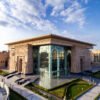Standing proudly on the western bank of the Nile River, the Colossi of Memnon captivate travelers and historians alike. Built during the reign of Pharaoh Amenhotep III, these enormous statues have endured the test of time, drawing visitors for centuries. This article explores the history, legends, and ongoing mysteries surrounding these remarkable monuments.

The Colossi of Memnon are two statues, each approximately 18 meters (59 feet) tall, portraying Pharaoh Amenhotep III seated on his throne. Erected around 1350 BCE, they once guarded the entrance to Amenhotep’s vast mortuary temple, one of the grandest in ancient Egypt. Carved from sandstone, each statue features Amenhotep III in regal attire, with his hands resting on his knees. Though earthquakes and natural events have damaged them, they remain an impressive sight and a powerful reminder of Egypt’s ancient splendor.
Legends and Mysteries of the Colossi of Memnon

Among the most captivating aspects of the Colossi of Memnon is the “Memnonian Sound.” At dawn, ancient accounts describe a soft, musical sound emanating from the statues, which many believed to be the voice of Memnon, a legendary hero. Interestingly, modern research now suggests that this sound likely resulted from temperature-induced contractions in the sandstone. Nevertheless, the legend endures, adding even more allure to these mysterious statues.
The statues have inspired countless myths and legends across history, enhancing their cultural significance. Despite the damage sustained over centuries, the Colossi stand resilient as enduring symbols of ancient Egypt. Archaeologists actively study the statues and their surroundings to better understand their original context and manage tourism impact. Conservation projects aim to protect these statues and preserve Egypt’s heritage.

Today, the Colossi of Memnon stand as a major tourist attraction, and ongoing efforts aim to preserve and protect them. Moreover, archaeological studies continue to explore the original context of the statues and their surrounding structures. In addition, preservation efforts actively manage tourism impact, ensuring the Colossi remain a lasting testament to Egypt’s heritage.
Why They Matter
The Colossi of Memnon symbolize the lasting legacy of ancient Egyptian civilization. Their massive size and surrounding legends reflect the power of the Pharaohs and the skill of Egyptian artisans. Through studying these statues, we gain a deeper understanding of Egypt’s architectural and cultural achievements.
At Odysseys Voyage, we offer a gateway to Egypt’s rich history, including experiences at the Colossi of Memnon. While the Colossi are accessible, Egypt is filled with countless other fascinating sites waiting to be explored. Discover our Egypt Travel Packages or request a tailor-made experiences to customize your journey through Egypt’s timeless wonders.




